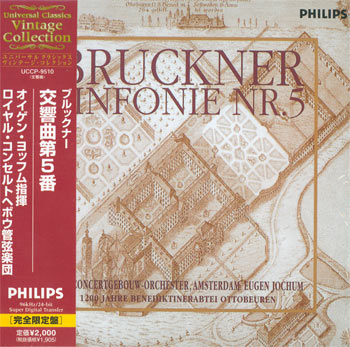Logowanie
Mikołaj - ten to ma gest!
Miles Davis, Horace Silver, Jay Jay Johnson, Percy Heath, Kenny Clarke, Lucky Thompson
Walkin'
20bit K2Super Coding - ale jak to brzmi!
Kasety magnetofonowe
Winylowy niezbędnik
ClearAudio
Double Matrix Professional - Sonic
najbardziej inteligentna i skuteczna pralka do płyt winylowych wszelkiego typu - całkowicie automatyczna
BRUCKNER, Royal Concertgebouw Orchestra, Eugen Jochum
Symphony No. 5
- Bruckner - Jochum Symphony No. 5
- 01. Introduction(Adagio) - Allegro(Massig) (21:04)
- 02. Adagio (Sehr langsam) (18:58)
- 03. Scherzo (Molto vivace, schnell) (12:46)
- 04. Finale (Adagio - Allegro moderato) (23:09)
- Eugen Jochum - conductor
- Royal Concertgebouw Orchestra - orchestra
- BRUCKNER
Review by: ClassicsToday Artistic Quality: 8 Sound Quality: 7 This imposing recording of Bruckner’s Symphony No. 5 was made in May, 1964 at the Benedictine Abbey of Ottobueren, Germany, during celebrations marking the abbey’s 1200th anniversary. The performance, by Eugen Jochum and the Amsterdam Concertgebouw Orchestra, is an aptly monumental one, and it would have been hard to select another musical work much better suited to the occasion. Collectors who remember this performance from LP days probably will have legitimate concerns about its formerly over-congested brass climaxes. Additionally, the reverberant church setting, with its very lively and rather unpredictable acoustic, often clouded inner textual detailing. On both counts, it’s good to find that Philips’ new 24 bit digital transfer has revised previous sonic impressions of this accomplished performance. It now sounds far better balanced, with improved spatial detailing (particularly among woodwind instruments), richer strings (there’s less shrillness in high register violin passages), and, most importantly, believable focus and impact in the heavy brass, which no longer obliterates everything else at major climactic points. Jochum’s view of the Fifth remained unusually consistent across his several recordings of the work, all of which rate highly for clarity of vision and watchful management of tempo-related issues. But there was a certain moving simplicity, too, in the way Jochum simply allowed the symphony to unfold at its own unhurried pace, though this Philips version also retains a certain ritualistic symbolism, owing as much to the devotional setting in which the recording was made as to Jochum’s old-fashioned interpretive values. His handling of the Adagio is a case in point; he encourages his players to phrase and vocalize solos with real individuality (the Concertgebouw clarinets and bassoons are particularly idiomatic), but still insists on a pretty unbending rhythmic grip. The labyrinthine double fugue of the finale tends to be too controlled, but that most likely reflects Jochum’s concern to achieve clarity in a less than perfect acoustic. That so much contrapuntal detailing registers clearly justifies any stiffness of approach–but the finale goes better in Jochum’s Dresden Staatskapelle recording, now available as part of the Musical Heritage Society’s 9-disc Bruckner set. That version, also recorded in a church (the Lukaskirche in Dresden, in March, 1982–with required sound-dampening measures in place) would be a first choice if you want Bruckner Five under Jochum. It’s certainly finer than his Bavarian RSO version for Deutsche Grammophon. Lastly, there’s such a strong congruency of view in Jochum’s performances that you can make a judgement largely on sonics; most are finely played, but the Philips account also has a sense of occasion not matched by the Dresden (MHS) or Munich (DG) versions.































